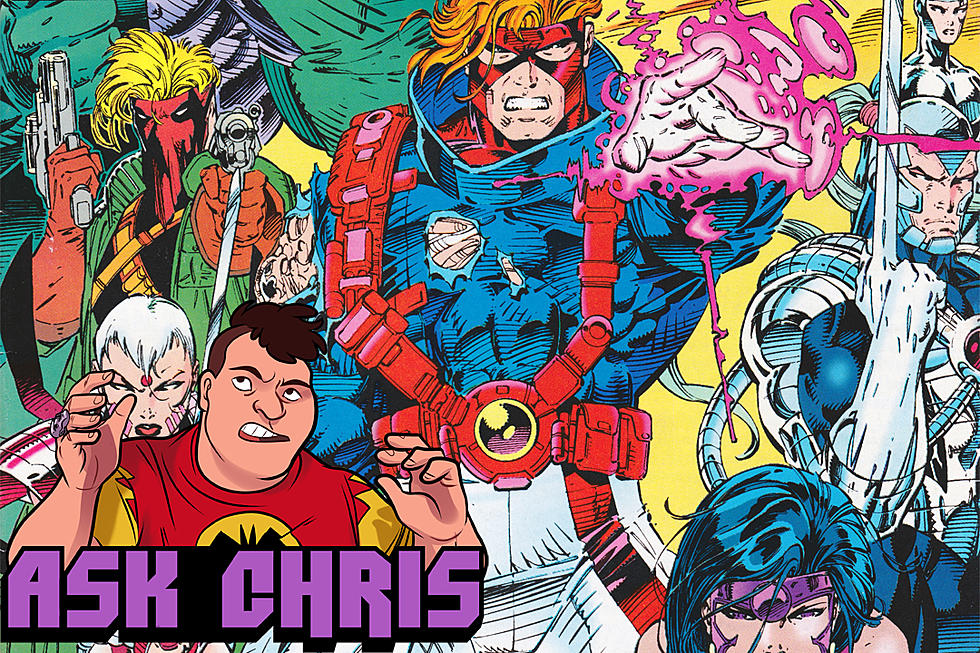
Warren Ellis had the Best Week Ever
Last week was a big one for our friend Warren Ellis. Aside from contracting what he diagnosed as San Diego SARS and downing something like five pallets of Red Bull at what is assured to be one of his last Comic-Cons in quite a while--and you should check out John's stellar on-the-scene reportage for all the tidbits and gory details of that adventure--he released the first issues of two new comic series, a graphic novel and his first ever p rose novel-quite a hefty load, so much so that its taken me this long to parse through the material, develop one or two cogent thoughts and present you here with my mega-Warren-Ellis-review bonanza! So light a cigarette, down a Red Bull and strap on your seatbelt because we're diving right in to the demented, demonic, deranged and delightful mind of our favorite British comic-titan.
rose novel-quite a hefty load, so much so that its taken me this long to parse through the material, develop one or two cogent thoughts and present you here with my mega-Warren-Ellis-review bonanza! So light a cigarette, down a Red Bull and strap on your seatbelt because we're diving right in to the demented, demonic, deranged and delightful mind of our favorite British comic-titan.
I've already reviewed Crooked LIttle Vein, so I'll only go so far as to say, for actually the third time on this blog, Godzilla porn. But let's do talk about his graphic novel, Crécy, inspired by the epic 1346 Battle of Crécy between the English and the French during the Hundred Years' War that, due to advanced weaponry and barbaric tactics, many historians point to as the beginning of the end of chivalry. Gee, I wonder why this one had appeal for Ellis?
Published by Avatar, the story follows William of Stonham, a longbowman for King Edward III of England who has been pillaging French villages in service to the King. Why? The English could always use more land, he says, and "the more we own, the less chance of French people rowing across the channel and invading us." Their march is leading them to Crécy, where the French intend to make their stand. They're outnumbered nearly four to one, and not really expected to survive the battle.
But this "story" is more like background information-most of what you've just read I had to research after the fact. Ellis offers little in terms of plot and narrative, and instead crafts a "how-to" guide for medieval warfare. The reader is treated to in-depth explanations of the sorts of tactics the English used to distinguish this battle in historians' minds as the beginning of barbarism. Arrowheads, for example, should be loosely attached to the shaft so that when the enemy tries to pull the arrow out, the metal is lost in the body. They should also be buried in dirt beforehand, to increase the chance of infection should the enemy survive the hit. And as for the sword, a nice pre-combat bath in a latrine should ensure your enemy dies from the merest scratch.
The history lesson Ellis crafts from this snapshot is as meticulous in detail as it is fascinating, presenting a portrait of a period's sensibilities we imagine he probably identifies with on a profound level. Finally, a culture as obsessed with dirt and shit as me! Presenting this snapshot with almost no narrative, Ellis has crafted a novel that is both typical and atypical to his style and fashion-perhaps not best for everyone, but a welcome treat to the devoted.
 Moving away from the past into the future, Ellis's long-awaited first issue of Doktor Sleepless, also published by Avatar, focuses on a world not too dissimilar from the one William Gibson painted in Neuromancer, technologically advanced and entirely interconnected, but utterly dystopic. His characters wear contact lenses that give them access to the world's content: music, movies, even their friends' whereabouts and health status (one character finds out a popular radio DJ has died when he signs off his instant messenger). But of course, the more technology the world is presented with, the more it wants. "This is not my future," "Where's my f______ jetpack?" and "You owe me a flying car" graffiti riddle the city's walls. People have instead focused their rage inwards, mutilating and modifying their bodies-grinding them, he calls it--like they're obsolete pieces of hardware in need of more RAM.
Moving away from the past into the future, Ellis's long-awaited first issue of Doktor Sleepless, also published by Avatar, focuses on a world not too dissimilar from the one William Gibson painted in Neuromancer, technologically advanced and entirely interconnected, but utterly dystopic. His characters wear contact lenses that give them access to the world's content: music, movies, even their friends' whereabouts and health status (one character finds out a popular radio DJ has died when he signs off his instant messenger). But of course, the more technology the world is presented with, the more it wants. "This is not my future," "Where's my f______ jetpack?" and "You owe me a flying car" graffiti riddle the city's walls. People have instead focused their rage inwards, mutilating and modifying their bodies-grinding them, he calls it--like they're obsolete pieces of hardware in need of more RAM.
Enter John Reinhardt, a man who has most likely lost more than a few of his marbles, but seems nevertheless determined to set a few things straight. How does he do this? By grinding of course: "Today I become a character," he says. "John Reinhardt and all the things he's seen: he's a bit too real. The things he wants to do are a bit too obvious...But Doktor Sleepless. He's something else entirely." I can't help but be reminded of Batman Begins, when Ducard says, "If you make yourself more than just a man, if you devote yourself to an ideal...you become something else entirely."
If this comic were an election, I'd file it under "Too Close to Call." Aside from presenting yet another iteration of a less-than-ideal future, Ellis hasn't given the reader very much to go with. His mad scientist has a "prescription" to fix the world, yet at this point we have no conception what that might be, other than the fact that it requires a Frankensteinian amount of electricity to accomplish. Nor do we have much of a clue what his motivations are aside from an understandable moral distaste for body mutilation. For what it's worth, however, Ellis's relationship with body mutilation seems to border more on curiosity than it does distaste.
The first issue has piqued my curiosity--and it takes a lot for me to waver away from Ellis-so I'll just say that this story is in need of more issues for its plot to flesh out. And I will give Ellis props for devising what is quite possibly the greatest tagline ever: "What America Needs Now is a Mad Scientist" (He probably came up with that before he did the storyline). But the first issue definitely didn't grab me the same way Black Summer did last month.
story is in need of more issues for its plot to flesh out. And I will give Ellis props for devising what is quite possibly the greatest tagline ever: "What America Needs Now is a Mad Scientist" (He probably came up with that before he did the storyline). But the first issue definitely didn't grab me the same way Black Summer did last month.
The political intrigue that filled the pages of the prologue issue of Black Summer, which I review here, is much less prominent in issue #1. The act of, and motivations for, killing the President of the United States have already been visited, and now the characters are left with the aftermath. As I said in my previous review, the comic closely examines vigilantism from a psychological point of view. What sort of man dons a mask, and what are the inherent dangers in doing so? Post-assassination, however, the pressing question is no longer whether John Horus was justified, but just how dangerous he and his Seven Guns teammates have become. If one has lost it, surely they all have.
The implications of this presumption in a George-Bush-shoot-now-ask-questions-later era are obvious, so the issue is filled with Ellis's second-favorite sub
ject matter after social and political critique: straight-up hardcore blood, guts and violence. While the government desperately tries to hunt down the surviving members of the ill-fated super squad, the heroes themselves are left to pick up the shambles of their lives, revealing on the run just how insane they've all become.
In a way, Ellis has set the stage for his own Civil War in issue #1. Where will the remaining heroes stand: with the government that fears them and wants them dead, or with their former teammate who's fit for a straightjacket? Still more questions than answers, but the story thus far promises to be far from uncomplicated. With nearly every character in the book fitting stereotypes for both the hero and the villain, maybe America is in need of a mad scientist after all.
More From ComicsAlliance

![Jenny Sparks Enters The Scene In Ellis And Davis Hunt’s ‘The Wild Storm’ #3 [Preview]](http://townsquare.media/site/622/files/2017/03/TWS_Cv3_000.png?w=980&q=75)







